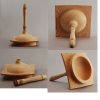How do you safely saw spindle work in half - long ways?
I have an idea for a craft show item but I'll need to split the item in half after turning. I have thought of the paper joint but that is a lot of prep and I have too much rough dry turning stock to spend time a jointer etc.
Assume Minimum dia of 1/2" and max of 1 1/2" and 3 to 6 inches long.
A picture of fixture or method would be great. Thanks
Frank
I cut spindle-turned items like this, sometimes as large as 12" diameter and bulged in the middle as well. You can safely cut a spindle-turned object lengthwise by affixing it to a scrap of plywood or even heavy cardboard. Use hot-melt glue to attach the spindle to the plywood. I sometimes also use masking tape to hold the object, especially if it also has a bulge and doesn't lay flat. I wrap the masking tape completely around the object and the base it's sitting on.
If the object is really unstable (bulged in the middle and rocking), then you can hot-melt-glue wedges under various sections to stabilize the object.
The most important area to stabilize is the end where the wood is cut last.
Once you've successfully adhered the object to a base of plywood or cardboard or MDF or whatever, then simply cut it lengthwise, holding the base that the object is glued to as you push it through the bandsaw blade (keeping your fingers to the side of the blade).
The hot-melt glue comes off of most wood quite easily. But if it doesn't, simply heat the glue with a hairdryer, then peel the glue off.
I once had a student cut a 14" diameter sphere in half using this quick-jig method. We made the cut safely and easily. We did use a lot of wedges, hot-melt glue, tape and a fairly thick plywood base.
Good luck and don't place anything in front of the bandsaw blade that you don't want to have cut . . . like your fingers.
Betty Scarpino, editor,
AW
